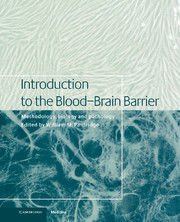Book contents
- Frontmatter
- Contents
- List of contributors
- 1 Blood–brain barrier methodology and biology
- Part I Methodology
- Part II Transport biology
- Part III General aspects of CNS transport
- 27 The blood-CSF barrier and the choroid plexus
- 28 Arachnoid membrane, subarachnoid CSF and pia–glia
- 29 Circumventricular organs of the brain
- 30 Transport in the developing brain
- Part IV Signal transduction/biochemical aspects
- Part V Pathophysiology in disease states
- Index
27 - The blood-CSF barrier and the choroid plexus
from Part III - General aspects of CNS transport
Published online by Cambridge University Press: 10 December 2009
- Frontmatter
- Contents
- List of contributors
- 1 Blood–brain barrier methodology and biology
- Part I Methodology
- Part II Transport biology
- Part III General aspects of CNS transport
- 27 The blood-CSF barrier and the choroid plexus
- 28 Arachnoid membrane, subarachnoid CSF and pia–glia
- 29 Circumventricular organs of the brain
- 30 Transport in the developing brain
- Part IV Signal transduction/biochemical aspects
- Part V Pathophysiology in disease states
- Index
Summary
Introduction
The environment of the neurons, the brain interstitial fluid (ISF), is protected from fluctuations in the composition of the blood by two barriers. The first and largest interface is that of the blood–brain barrier (BBB) located at the cell walls and the tight junctions between the cells of the cerebral endothelium, i.e. ‘tight’ capillaries. The second is a composite barrier, the blood–cerebrospinal fluid barrier (BCSFB) and is made up of the choroid plexuses, the arachnoid membrane and the circumventricular organs. These tissues have fenestrated ‘leaky’ capillaries and their barrier function is provided by the tight junctions between the cells of their modified ependymal layer (Davson and Segal, 1996).
The choroid plexuses (CP) are located in the two lateral ventricles and the third ventricle with a further CP in the fourth ventricle as a single sheet of tissue that forms the roof of this cavity. The external covering (CSF side) of these structures is modified ependymal cells that closely resemble a transporting epithelium such as found in the nephron. The cell walls on the CSF or apical side of these cells are covered with microvilli, which greatly expands the surface area at the interface between the cytoplasm and CSF (Fig. 27.1).
- Type
- Chapter
- Information
- Introduction to the Blood-Brain BarrierMethodology, Biology and Pathology, pp. 251 - 258Publisher: Cambridge University PressPrint publication year: 1998
- 4
- Cited by



